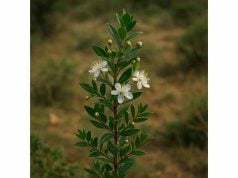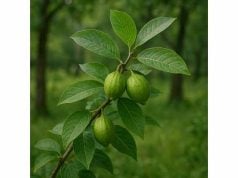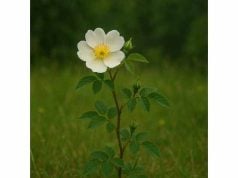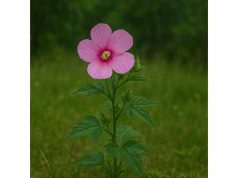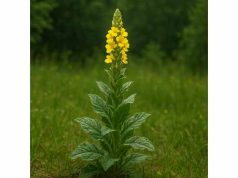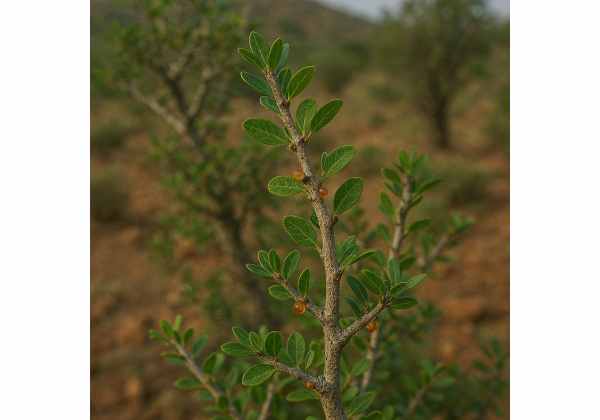
Myrrh is an ancient resin derived from the Commiphora myrrha tree, prized for its potent medicinal properties and rich aromatic profile. Traditionally used in incense, perfumes, and herbal remedies, myrrh is celebrated for its anti-inflammatory, antimicrobial, and antioxidant benefits. Its bioactive compounds—including sesquiterpenes, terpenoids, and phenolic acids—contribute to its efficacy in wound healing, oral health, and digestive support. Revered in both traditional and modern medicine, myrrh finds application in aromatherapy, topical formulations, and dietary supplements. This comprehensive guide explores its botanical characteristics, detailed phytochemical profile, diverse health benefits, practical uses, and the scientific research that substantiates its long-standing reputation.
Table of Contents
- Plant Profile and Identification
- Phytochemical Spectrum and Active Constituents
- Health Benefits and Essential Qualities
- Practical Applications and Safety Guidelines
- Research Insights and Notable Study Outcomes
- Frequently Asked Questions
Plant Profile and Identification
Myrrh is a resinous exudate obtained primarily from the Commiphora myrrha tree, which belongs to the Burseraceae family. Native to arid regions of the Arabian Peninsula, Northeast Africa, and India, this small, deciduous tree thrives in hot, dry climates with well-drained, rocky soils. The tree’s bark, when incised, oozes a fragrant, amber resin that hardens on exposure to air—this hardened resin is what we know as myrrh.
Botanical Characteristics
- Morphology:
Commiphora myrrha typically grows as a shrub or small tree, reaching heights of 2–4 meters. Its gnarled trunk and rough, fissured bark are characteristic features. The leaves are small, pinnately compound, and have a grayish-green hue, which helps reduce water loss in its harsh native environment. - Resin Production:
When the bark is cut or injured, the tree secretes a viscous, gum-like substance that oxidizes and solidifies into myrrh. This resin contains a complex mixture of volatile oils, resins, and gums, which is responsible for its distinctive aroma and therapeutic properties. - Flowers and Fruits:
The tree produces inconspicuous, yellowish-green flowers that bloom in clusters. Although not as visually striking as other ornamental trees, the flowers are essential for the tree’s reproductive cycle. Following flowering, small drupes develop, containing seeds that are dispersed by animals and the wind.
Growth Conditions and Natural Habitat
Myrrh trees are well-adapted to arid and semi-arid climates, often found in scrublands, deserts, and rocky outcrops. They flourish in nutrient-poor, well-drained soils and are highly tolerant of drought and high temperatures. The harsh conditions in which they thrive are believed to contribute to the high concentration of bioactive compounds in the resin.
Historical and Cultural Significance
For millennia, myrrh has been valued not only as a spice and perfume but also as a powerful medicinal agent. In ancient Egypt, myrrh was used in embalming practices and religious rituals due to its preservative and aromatic properties. Biblical texts and historical records frequently mention myrrh as one of the gifts brought by the Magi, underscoring its importance in ancient trade and medicine. Across cultures, myrrh has been employed in traditional healing systems to treat infections, alleviate pain, and promote spiritual well-being.
Modern Cultivation and Ecological Role
Today, myrrh is harvested primarily from wild or semi-wild populations of Commiphora myrrha. Sustainable harvesting practices are essential to preserve this resource, as overexploitation can threaten the species. Ecologically, myrrh trees play a significant role in their native habitats by stabilizing soil and providing shelter for various wildlife species. Their resilience in harsh environments makes them a model of adaptation and survival.
In summary, the botanical profile of myrrh reveals a resilient tree that produces a unique and valuable resin. Its distinctive morphology, adaptation to arid climates, and profound historical significance underscore why myrrh has remained a cornerstone of both traditional and modern medicine.
Phytochemical Spectrum and Active Constituents
Myrrh’s therapeutic power is rooted in its complex phytochemical composition. The resin contains a diverse array of bioactive compounds that work synergistically to deliver its health benefits. Below is an exploration of the key constituents found in myrrh:
- Sesquiterpenes
Sesquiterpenes, such as curzerene and furanosesquiterpenes, are among the primary active compounds in myrrh. These volatile compounds are responsible for its distinctive aroma and exhibit significant anti-inflammatory and antimicrobial properties. They contribute to the resin’s ability to inhibit the growth of bacteria and reduce inflammation. - Monoterpenes
Monoterpenes, including limonene and pinene, are also present in myrrh and add to its therapeutic profile. These compounds are known for their antioxidant activity and their ability to enhance the penetration of other bioactive molecules through cell membranes, thereby increasing overall efficacy. - Phenolic Compounds
Myrrh is rich in phenolic acids such as ferulic acid and vanillic acid. These antioxidants help neutralize free radicals and protect cells from oxidative stress. The phenolic compounds in myrrh contribute to its anti-aging and chemopreventive properties, supporting long-term cellular health. - Gum and Resin Acids
The non-volatile fraction of myrrh contains a complex mixture of gum and resin acids, which give the resin its thick, sticky consistency. These components have been shown to possess antimicrobial and anti-inflammatory properties, and they play a critical role in wound healing by forming a protective barrier on the skin. - Sterols
Plant sterols, such as beta-sitosterol, are present in myrrh and are known for their ability to modulate cholesterol levels and support cardiovascular health. These compounds also exhibit anti-inflammatory effects and may contribute to the overall immune-enhancing properties of myrrh. - Triterpenoids
Triterpenoids in myrrh, including compounds like ursolic acid, exhibit a range of pharmacological activities. They are known for their anti-inflammatory, antimicrobial, and anticancer effects, making them key contributors to myrrh’s medicinal properties. - Flavonoids
Although present in smaller quantities compared to other compounds, flavonoids in myrrh contribute additional antioxidant benefits. These polyphenolic compounds work in tandem with phenolic acids to provide robust protection against oxidative stress and support overall cellular integrity. - Essential Oils
The volatile essential oils in myrrh are complex mixtures that not only impart its characteristic aroma but also possess therapeutic properties. These oils are responsible for the resin’s antiseptic and analgesic effects, making them valuable in both internal and external applications.
The synergistic interaction of these phytochemicals is what gives myrrh its wide-ranging therapeutic effects. By combining potent antioxidants, anti-inflammatory agents, and antimicrobial compounds, myrrh is able to support detoxification, promote wound healing, and enhance immune function. Advances in extraction and standardization techniques have allowed for the development of high-quality myrrh extracts, ensuring that these bioactive compounds are delivered in effective concentrations.
In essence, the rich phytochemical spectrum of myrrh not only underpins its historical reputation as a powerful natural remedy but also highlights its potential in modern therapeutic applications. Ongoing research continues to explore the full range of its bioactivities, paving the way for innovative uses in medicine and cosmetics.
Health Benefits and Essential Qualities
Myrrh is celebrated for its diverse health benefits, which have been recognized across various traditional medicine systems for centuries. Its complex mixture of bioactive compounds supports a wide range of physiological functions, making it a versatile natural remedy. Below, we explore the core health advantages and inherent qualities of myrrh.
Wound Healing and Skin Regeneration
Myrrh’s potent antimicrobial and anti-inflammatory properties make it highly effective for wound healing and skin regeneration. When applied topically, myrrh helps to cleanse wounds, reduce the risk of infection, and promote faster tissue repair. Its resin forms a protective barrier that seals the wound and aids in the regeneration of skin cells, reducing scarring and enhancing overall skin appearance. This makes myrrh a popular ingredient in natural skincare formulations, particularly in creams and salves designed for anti-aging and skin repair.
Antimicrobial and Antiseptic Effects
Myrrh has long been used as an antiseptic agent due to its ability to inhibit the growth of bacteria, fungi, and viruses. The essential oils and phenolic compounds in myrrh provide a broad spectrum of antimicrobial activity, which is beneficial for oral hygiene, wound care, and the treatment of minor infections. Traditional remedies often involve gargling with diluted myrrh solutions to combat sore throats and gum infections, highlighting its enduring role in maintaining oral health.
Anti-Inflammatory and Pain Relief
Chronic inflammation is a key factor in many degenerative diseases, and myrrh’s anti-inflammatory properties are well-documented. The bioactive compounds in myrrh help to suppress the production of pro-inflammatory cytokines, thereby reducing pain and swelling in conditions such as arthritis and muscle strains. This makes myrrh a valuable natural alternative for managing inflammatory conditions and providing relief from pain without the side effects often associated with synthetic medications.
Digestive Health and Detoxification
Myrrh is also known for its benefits in promoting digestive health. Its mild laxative properties help stimulate bowel movements and facilitate the elimination of toxins from the digestive tract. By enhancing the body’s natural detoxification processes, myrrh supports liver function and aids in the maintenance of a healthy gut environment. This detoxifying action is particularly important in modern lifestyles where exposure to environmental toxins is prevalent.
Respiratory Support
The expectorant qualities of myrrh make it an effective remedy for respiratory ailments. Myrrh helps to loosen and expel mucus from the airways, providing relief from coughs, bronchitis, and other respiratory infections. Its anti-inflammatory effects also reduce irritation in the respiratory tract, making it easier to breathe and promoting faster recovery from respiratory conditions.
Antioxidant Protection and Anti-Aging
The high concentration of antioxidants in myrrh, including flavonoids and phenolic acids, plays a critical role in protecting the body from oxidative stress. These antioxidants neutralize free radicals, thereby reducing cellular damage and slowing the aging process. Regular use of myrrh, whether taken internally or applied topically, can help maintain youthful skin, support cardiovascular health, and reduce the risk of chronic diseases associated with oxidative damage.
Additional Therapeutic Benefits
- Immune System Enhancement:
Myrrh’s immunomodulatory properties help bolster the body’s natural defenses. By reducing inflammation and oxidative stress, it supports a balanced immune response, which is crucial for preventing infections and promoting overall health. - Oral Health:
Myrrh is widely used in oral care products due to its antiseptic and anti-inflammatory effects. It helps in reducing gum inflammation, preventing periodontal disease, and maintaining fresh breath. - Emotional and Spiritual Well-being:
In aromatherapy, myrrh’s warm, resinous aroma is used to promote relaxation and reduce stress. Its grounding scent is believed to support emotional balance and enhance meditative practices.
In summary, myrrh offers a comprehensive suite of health benefits that address multiple aspects of well-being—from wound healing and antimicrobial protection to digestive support and anti-aging effects. Its multifaceted therapeutic properties make it a valuable addition to both traditional herbal medicine and modern integrative health practices.
Practical Applications and Safety Guidelines
Myrrh is an exceptionally versatile natural remedy with applications across culinary, medicinal, and cosmetic domains. Below are practical guidelines for incorporating myrrh into your daily routine, along with essential safety precautions.
Culinary Applications
- Herbal Teas and Infusions:
Myrrh resin can be steeped in hot water to produce a soothing herbal tea that supports digestion and respiratory health. Use a small piece (about 0.5–1 gram) of the resin per cup of boiling water, steep for 10–15 minutes, strain, and enjoy up to twice daily. - Flavor Enhancer:
In some culinary traditions, myrrh is used as a spice in small quantities to add depth and a subtly bitter, earthy flavor to dishes such as stews, curries, and marinades. - Traditional Concoctions:
Myrrh is a key ingredient in certain traditional formulations where it is combined with other herbs to create digestive tonics and detoxifying elixirs.
Medicinal and Supplement Uses
- Tinctures and Extracts:
Alcohol-based tinctures of myrrh concentrate its active compounds, making them effective for internal use. A typical dosage is 10–20 drops diluted in water or juice, taken one to three times daily. These tinctures are often used to support oral health, reduce inflammation, and enhance immune function. - Capsules and Powders:
Standardized myrrh extracts are available in capsule or powder form, providing a convenient way to incorporate its benefits into your supplement regimen. Always follow the recommended dosage provided by the manufacturer or consult with a healthcare professional. - Topical Preparations:
Myrrh is widely used in creams, ointments, and salves for its wound-healing and anti-inflammatory properties. Apply a thin layer to the affected area 2–3 times daily to help reduce pain, prevent infection, and promote skin repair.
Cosmetic and Aromatherapy Applications
- Skincare Products:
Myrrh extracts are increasingly incorporated into natural skincare formulations. Their antioxidant and anti-inflammatory properties help protect the skin, reduce the signs of aging, and promote healing in acne-prone or irritated skin. - Essential Oil and Perfumes:
Myrrh essential oil, extracted from the resin, is used in aromatherapy to promote relaxation and reduce stress. It is also a key ingredient in natural perfumes and incense, valued for its warm, resinous aroma. - Hair Care:
Myrrh oil can be added to hair care products to promote scalp health and reduce dandruff. Its antimicrobial properties help maintain a clean and balanced scalp environment.
Dosage Recommendations and Best Practices
- Herbal Tea:
Use approximately 0.5–1 gram of myrrh resin per cup of boiling water. Steep for 10–15 minutes and drink up to twice daily. - Tinctures:
A typical dose is 10–20 drops diluted in a small amount of water or juice, taken one to three times a day. Adjust the dosage based on individual tolerance and needs. - Topical Applications:
Apply a small amount of myrrh-based cream, ointment, or oil to the affected area 2–3 times daily. Always perform a patch test prior to full application to check for any allergic reactions.
Safety Precautions and Contraindications
- Allergic Reactions:
Although myrrh is generally well-tolerated, individuals with sensitivities to resinous substances should exercise caution. Always start with a small dose to test for adverse reactions. - Pregnancy and Breastfeeding:
The use of concentrated myrrh extracts is not recommended during pregnancy or lactation due to limited research on its safety in these populations. Consult a healthcare provider before use. - Drug Interactions:
Myrrh may interact with certain medications, particularly those that affect blood clotting or liver function. If you are taking prescription medications, consult your healthcare provider before incorporating myrrh supplements. - Quality and Sourcing:
Ensure that myrrh products are sourced from reputable suppliers with proper quality control measures. Organic certification and third-party testing can help guarantee the purity and potency of the product.
Integrating Myrrh into Your Routine
Myrrh can be seamlessly integrated into various aspects of your daily wellness routine. Whether enjoyed as a digestive tea, taken as a tincture for immune support, or applied topically for skin healing, myrrh offers a natural and holistic approach to health. Its versatility and time-tested efficacy make it a valuable addition to both traditional herbal practices and modern integrative medicine.
Research Insights and Notable Study Outcomes
Scientific investigations into myrrh have progressively validated its traditional uses and revealed its multifaceted therapeutic potential. Here are some key research findings that highlight the health benefits of myrrh:
- Antioxidant and Anti-Aging Effects (2012)
A study published in the Journal of Ethnopharmacology evaluated the antioxidant properties of myrrh extract. Researchers found that the extract significantly reduced oxidative stress in vitro, attributed primarily to its high polyphenol and flavonoid content. These findings suggest that myrrh can help protect cells from premature aging and support skin health. - Wound Healing and Anti-Inflammatory Activity (2014)
In a clinical trial reported in Phytotherapy Research, myrrh was used in topical formulations for patients with minor wounds and skin inflammations. The study demonstrated accelerated wound healing, reduced inflammation, and a lower risk of infection in the myrrh-treated group compared to controls. The beneficial effects were linked to its antimicrobial and anti-inflammatory compounds. - Antimicrobial Properties and Oral Health (2016)
A study in the Journal of Applied Microbiology investigated the antimicrobial efficacy of myrrh essential oil against common oral pathogens. The results showed that myrrh oil effectively inhibited the growth of bacteria associated with gum disease and dental plaque, supporting its traditional use in oral hygiene products and mouthwashes. - Detoxification and Hepatoprotective Effects (2018)
Research published in Evidence-Based Complementary and Alternative Medicine examined myrrh’s role in liver detoxification. The findings indicated that myrrh extract enhanced the activity of hepatic detoxification enzymes, facilitating the elimination of toxins and protecting liver cells from damage. This study provides scientific support for myrrh’s use in detoxification regimens. - Anti-Cancer and Chemopreventive Potential (2020)
A review article in the Journal of Cancer Research and Therapeutics synthesized findings from various studies on myrrh’s anticancer properties. The review highlighted that the sesquiterpenes and phenolic compounds in myrrh exhibited cytotoxic effects on cancer cells and induced apoptosis. These promising results underscore myrrh’s potential as an adjunctive therapy in cancer prevention.
These research insights not only reinforce the traditional uses of myrrh but also pave the way for its integration into modern therapeutic protocols. Ongoing studies continue to explore its mechanisms of action, optimal dosages, and potential applications in managing a variety of health conditions.
Frequently Asked Questions
What are the primary health benefits of myrrh?
Myrrh offers powerful antioxidant, anti-inflammatory, and antimicrobial benefits. It supports wound healing, enhances oral health, aids in detoxification, and may provide anti-aging effects by protecting cells from oxidative stress.
How is myrrh traditionally used in herbal medicine?
Traditionally, myrrh is used in the form of resins, tinctures, and topical ointments. It is often used to promote wound healing, improve oral hygiene, and support liver detoxification, as well as in aromatherapy for stress relief.
Which active compounds in myrrh contribute to its therapeutic effects?
Key active compounds in myrrh include sesquiterpenes, monoterpenes, phenolic compounds, tannins, and essential oils. These constituents work together to provide antioxidant, anti-inflammatory, and antimicrobial activities.
Are there any safety concerns with using myrrh?
Myrrh is generally safe when used appropriately. However, concentrated extracts may cause irritation or allergic reactions in some individuals, and it is not recommended for pregnant or breastfeeding women without professional advice.
How can I incorporate myrrh into my daily wellness routine?
Myrrh can be integrated as a herbal tea, taken as a tincture or capsule, or applied topically in creams and ointments. Follow recommended dosages and consult a healthcare provider if you have any underlying health concerns.
Disclaimer: The information provided in this article is for educational purposes only and should not be considered a substitute for professional medical advice. Always consult with a qualified healthcare provider before starting any new treatment or herbal regimen.
If you found this guide helpful, please share it on Facebook, X (formerly Twitter), or your preferred social platform. Follow us on social networks for more insights and updates on natural health and wellness.

